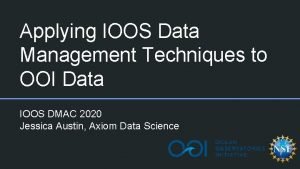OOI EPE RealTime Ocean Data Coming Soon to

- Slides: 1

OOI EPE: Real-Time Ocean Data Coming Soon to an Undergraduate Classroom Near You! Poster #1761 Michael Crowley 1 (crowley@rutgers. edu), S. Glenn 1, S. Lichtenwalner 1, J. Mc. Donnell 1, A. de. Charon 2, M. Mills 1, C. Companion 2, J. Wieclawek 3 1 Rutgers Institute of Marine & Coastal Sciences, 2 University of Maine Darling Center, 3 Raytheon Web Services Introduction to the OOI & EPE The NSF’s Ocean Observatories Initiative (OOI) will expand the ways in which ocean science research is conducted. The OOI will design, deploy and operate a large array of transformative research platforms and sensors. The sensors will collect the physical, biological, geological, chemical datasets necessary to understand the complex processes and challenges facing today's changing ocean. Recent advances in the delivery of web-based education, and the use of visualization technology in educational contexts, have led to the development of on-line platforms for instruction that engage students in active scientific inquiry by collecting and analyzing real world data. The OOI Education and Public Engagement (EPE) team is leveraging these technologies for ocean education. EPE is constructing three tools that are available through an integrated web portal that supports engagement of undergraduate educators. These tools, to be completed in early 2015, will enable educators to enhance their undergraduate education programs by using real-time and archived time series and profile data provided by the OOI and other sources. For the next 25 years, EPE will enable a new approach to oceanography research, where scientists, students and the public can explore the ocean in real-time from their classrooms, offices, dorm rooms, and homes. The face of an oceanographer will no longer be limited to a professor at sea, but expanded to a student at home viewing and analyzing exactly the same data at exactly the same time. The Integrated Tool Suite Educational Visualization Service The EPE team will provide the following to educators: • a web portal, enabling virtual collaboration and sharing of materials, • enhanced software for creating concept maps that can translate science concepts into education material, • a suite of educationally appropriate data visualization tools allowing students to explore data without Matlab, • and a step by step wizard to develop educational investigations with real-time data following best education practices. • • Provides flexible and customizable visualization tools Focused on time series and profiles from OOI and other sources Goal is to balance capability and usefulness Multiple entry points (teacher, student, developer) Investigation Builder • Community library of investigations • Online investigation template • Investigation Builder Wizard (step by step design process) • EPE resource integration Investigation Builder Single Integrated Web-based Portal OOI Data Educational Resource Database Visualization Concept Maps External Data Ocean and meteorological data are searchable by source, location, time and variable. • Supports content storage for Tools • Collects user supplied content (i. e. images, videos, documents) • Index of user generated EPE resources including education-ready OOI visualizations Three primary tools including the Investigation Builder, Concept Map Builder and Visualization Tools are accessible through a single integrated Web-Based Portal and sharable through a resource database. Integrated Web Portal • Common user interface • User support via help documentation & email • User profiles • Webinars/training Monthly Comparator tool showing ocean temperature for January 2009 -2012. Concept Map Builder • Concept Map Builder (create & edit) and Viewer • Concept & linking phrase suggestions (ontologies) • Embedded content resources such as descriptions, data visualizations, photos & videos from OOI & outside resources • Ontologies are being built to enable users to search and discover the links/relationships between OOI sites, platforms, instruments, data products and science themes. oceanobservatories. org Funding for the Ocean Observatories Initiative is provided by the National Science Foundation through a Cooperative Agreement with the Consortium for Ocean Leadership. The OOI Program Implementing Organizations are funded through subawards from the Consortium for Ocean Leadership. Any opinions, findings, and conclusions or recommendations expressed in this material are those of the author(s) and do not necessarily reflect the views of the National Science Foundation. We invite you to help us build the best tools by joining our beta site today, playing with the tools, and letting us know what you think. http: //education. oceanobservatories. org Looking for More Information? Locations of the OOI infrastructure currently being installed in the Atlantic and Pacific oceans. Major sites include Station Papa, Regional Scale Nodes, Endurance Array, Pioneer Array, Irminger Sea, Southern Ocean and the Argentine Basin. Construction is expected to be completed in the spring of 2015. In addition to EPE, the other OOI construction teams include: Regional Scale Nodes (RSN): RSN will deploy sensors off the coast of Washington to study Hydrate Ridge, an area of subseafloor gashydrate deposits, and Axial Seamount, an active submarine volcano. Coastal and Global Scale Nodes (CGSN): CGSN will deploy a global array of moorings and underwater gliders to provide sustained, but adaptable, access to complex coastal and global systems. Cyberinfrastructure (CI): The CI will provide a common operating infrastructure connecting and coordinating the operations of the marine components with the OOI scientific and educational pursuits. Program Management Office (PMO): The OOI program is funded by the National Science Foundation (NSF) and managed by the OOI PMO, located at the Consortium for Ocean Leadership (COL). Become an EPE Early Adopter In addition to the OOI booth here at Ocean Science 2014, EPE has four other posters in tonight’s session that present details on our tools including: • #1763 – Educational visualization tools by Sage Lichtenwalner • #1767 – Development of online visualization tools by Mike Mills • #1965 – Investigation Builder by Janice Mc. Donnell • #1764 – Using the EPE software to build an ocean acidification investigation by Oscar Schofield Acknowledgements A concept map example highlighting the ontology built that allows users to search the relationships for the Regional Scale Node Profiler Mooring. The user can see where the mooring type is located and what it contains, as well as click for a pop up definition the profiler. The OOI is funded by the National Science foundation and managed by the Consortium for Ocean Leadership. EPE would like to thank NSF for its years of dedication to the COSEE program as well as the OOI project.

